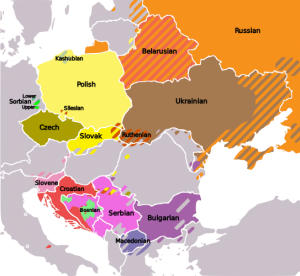3 Things to Understand about the Slavic Languages
By Sarah-Claire Jordan
 The Slavic languages are a group of languages that together form the second most common language group in Europe. The most common language group would be the Germanic languages, and the third most common is the Romance language group. You can find Slavic languages spoken throughout Central and Eastern Europe as well as the Balkans and some parts of Asia. The Slavic language you are probably the most familiar with is Russian, but there are at least 14 Slavic languages spoken today.
The Slavic languages are a group of languages that together form the second most common language group in Europe. The most common language group would be the Germanic languages, and the third most common is the Romance language group. You can find Slavic languages spoken throughout Central and Eastern Europe as well as the Balkans and some parts of Asia. The Slavic language you are probably the most familiar with is Russian, but there are at least 14 Slavic languages spoken today.
To better understand the Slavic languages, here are three important facts about them:
1. There are three branches of Slavic languages
The Slavic languages can be divided into three different branches. The first branch is the East Slavic branch, which includes Russian, Ukrainian, and Belarusian. The West Slavic branch is made up of Czech, Slovak, Polish, and more. The third branch is the South Slavic branch, which is further divided into Eastern and Western categories, where you can find Bulgarian, Macedonian, Serbian, Croatian, and Bosnian, among others. Some linguists believe that there may have been a North Slavic branch at some point in time, but they aren’t sure yet. Most languages within the same branch have a good level of mutual intelligibility.
2. All Slavic languages descended from the same language
The parent language for all of the Slavic languages is Proto-Slavic. It was spoken up to the 5th century AD in the same areas you can know find Slavic languages spoken. There is no written record of Proto-Slavic, which is common for proto languages. By around the 7th century AD, it started to divide into different dialects that later became the different Slavic languages. Immigration of peoples who spoke a language derived from Proto-Slavic created the different branches of the Slavic languages.
3. The Slavic languages share more characteristics than many other language groups
Besides belonging to the same language group and sharing a common ancestor, the Slavic languages have a lot more in common with each other than most other language families. They have more mutual intelligibility and are generally more homogenous. This is probably due to the fact that they were all just dialects of Common Slavic until the 10th century. Most of the Slavic languages also have retained many of the morphological characteristics of Proto-Slavic, making the grammar very similar from language to language. Many Slavic languages have consonant clusters, as well as very few nasal vowel sounds.
As you can see, the Slavic languages are probably much more common than you previously thought. Being the second largest language group in Europe, it makes sense that about 315 million people speak a Slavic language. Though there are only three branches currently, they encompass languages from Russian to Serbian. They all descend from Proto-Slavic, which didn’t differentiate into different dialects until the 7th century AD. This probably accounts for the similarities between the Slavic languages, as well as the fact that a lot of the morphology has been preserved. The Slavic language have more in common with each other than even the Romance language, which is saying a lot.
For an overview of our translation expertise, visit our telephone interpreting service page
Category: Foreign Language








